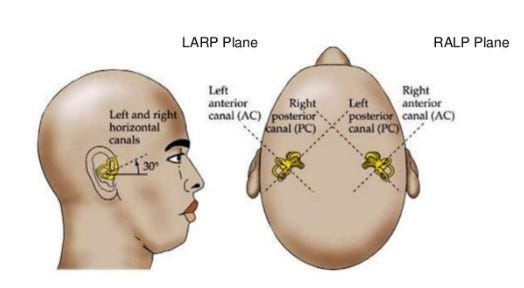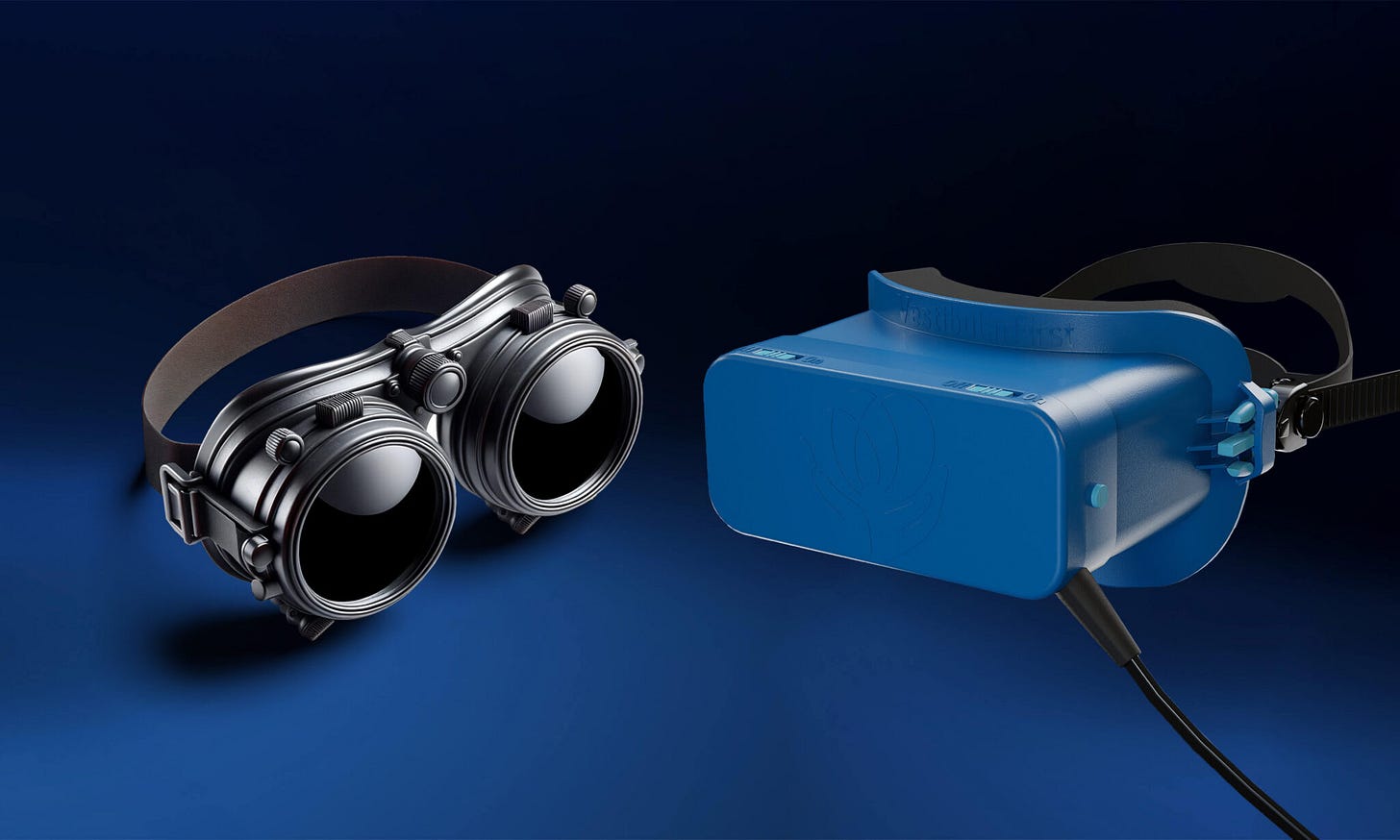Decoding Downbeating and Torsional Nystagmus: A Vestibular Professional's Perspective

I'll confess something that might surprise you: downbeating nystagmus with torsion used to fill me with a sense of dread - even still a little today. Even after years of experience as a vestibular therapist, I'd find myself staring at those subtle, shifting eye movements, feeling a knot of uncertainty tighten in my stomach.
It wasn't that I couldn't recognize downbeating nystagmus – that part was usually clear enough. But the torsion…oh, the torsion! It was like a mischievous imp, constantly playing tricks on my perception. What seemed like an apparent rightward twist would often turn out to be leftward upon closer inspection, and vice versa. This ambiguity shook my confidence and left me questioning my diagnostic skills.
I vividly remember those early days of teaching continuing education courses. Whenever we reached the section on downbeating nystagmus with torsion, I could almost feel the collective confusion rippling through the room. The puzzled faces, furrowed brows, and hesitant questions mirrored my internal struggle. It was clear that I wasn't alone in this diagnostic dilemma.
This frustration fueled a deep dive into the intricacies of vestibular assessment. I spent hours poring over textbooks, attending conferences, and analyzing countless videos of nystagmus. It was a journey of self-discovery, a quest to conquer this persistent challenge and empower myself and my fellow clinicians to diagnose and treat our patients confidently.
This article is the culmination of that journey. It's a roadmap to navigate the perplexing world of downbeating nystagmus with torsion. We'll explore the underlying principles, dissect common pitfalls, and equip you with practical tools and techniques to sharpen your diagnostic acumen.
But first, let me share the most valuable technique that transformed my understanding of downbeating nystagmus with torsion: the "flip the image" method.
Flip the Image: Your Secret Weapon
Imagine this: you're performing a Dix-Hallpike maneuver and observe what appears to be downbeating nystagmus with a rightward torsion. But doubt lingers. Is it truly a rightward torsion, or is your perception playing tricks on you?
Here's where the magic happens. Mentally flip the image of the eye movements. Picture the eyes moving in the opposite direction. If you were correct in your initial assessment, you should now see upbeat nystagmus with a leftward torsion.
Flipping the image can instantly clarify the direction of the torsion and boost your diagnostic confidence. It's a game-changer, and I can't emphasize its importance enough!
Why does this work?
The "flip the image" technique leverages the vestibular system's inherent symmetry and reciprocal relationships. Each canal has a partner in the opposite ear, and they work in a push-pull fashion. When one canal is excited, its partner is inhibited, and vice versa.
By flipping the image, you're essentially visualizing the nystagmus pattern produced by the paired canal. If your initial assessment of the downbeating nystagmus with torsion is correct, the flipped image will show the opposite pattern in the paired canal.
This technique is compelling and the cornerstone of confidently diagnosing downbeating nystagmus with torsion.
The Diagnostic Dilemma
Even with the "flip the image" technique in your arsenal, diagnosing downbeating nystagmus with torsion can still be tricky. Here's why:
Subtlety: The eye movements are often small and fleeting, making them difficult to observe.
Counterintuitive Nature: The direction of the torsion can seem to defy logic, especially when considering the patient's head position.
To illustrate this, let's look at two examples:
Example 1: This video shows downbeating nystagmus with rightward torsion. Notice how the slow phase of the nystagmus goes up and to the left while the fast phase goes down and to the right.
Example 2: This video shows downbeating nystagmus with leftward torsion. The slow phase goes up to the right, and the fast phase goes down to the left.
These examples highlight the importance of careful observation and the need for tools and techniques to enhance visualization.
Excitatory and Inhibitory Nystagmus: The Push and Pull
We must understand excitatory and inhibitory nystagmus to grasp the complexities of downbeating nystagmus with torsion fully. Each semicircular canal can generate two types of nystagmus:
Excitatory Nystagmus: Occurs when the canal is stimulated, causing the eyes to beat in a specific direction.
Inhibitory Nystagmus: Occurs when the canal is inhibited, causing the eyes to beat in the opposite direction.
This push-pull dynamic is crucial for maintaining balance and coordinating eye movements.
Paired Canals: The RALP and LARP Planes
The vestibular system is beautifully organized into functional pairs known as the RALP (Right Anterior, Left Posterior) and LARP (Left Anterior, Right Posterior) planes. These planes represent a reciprocal relationship between canals in opposite ears.
When one canal in a pair is excited, its partner is inhibited. This interplay is essential for interpreting nystagmus patterns and pinpointing the source of vestibular dysfunction.
Right Anterior Canal - Downbeat & Torsion to the right is paired with…
Left Posterior Canal - Upbeat & Torsion to the left.
Left Anterior Canal - Downbeat & Torsion to the left is paired with…
… Right Posterior Canal - Upbeat & torsion to the right.
Enhancing Visualization: Tools and Techniques
Visualizing the subtle eye movements of downbeating nystagmus with torsion can be challenging. Here are some tools and techniques to enhance your observation:
Frenzel Goggles: These specialized goggles magnify the eyes and eliminate visual fixation, making nystagmus easier to observe.
Video-oculography (VOG): This technology uses infrared cameras to track eye movements, providing precise measurements and recordings.
Online Resources: Websites like Dr. Michael Teixido offer valuable videos and demonstrations of various nystagmus patterns.
Clinical Pearls for Vestibular Professionals
Careful Observation: Take your time and observe the patient's eye movements in various gaze positions.
Consider the "Mirror" Effect: Remember the reciprocal relationship between paired canals.
Factor in Excitatory/Inhibitory Influences: Analyze the direction of nystagmus relative to the affected vestibular pathway.
Utilize Visualization Tools: Employ Frenzel goggles, VOG, or online resources to enhance your observations.
Apply the "Flip the Image" Technique: This is your secret weapon for confidently diagnosing downbeating nystagmus with torsion.
By integrating these strategies, you can confidently approach the diagnostic challenges posed by downbeating nystagmus with torsion. This comprehensive understanding will empower you to provide accurate assessments and effective management for your patients with vestibular disorders.









